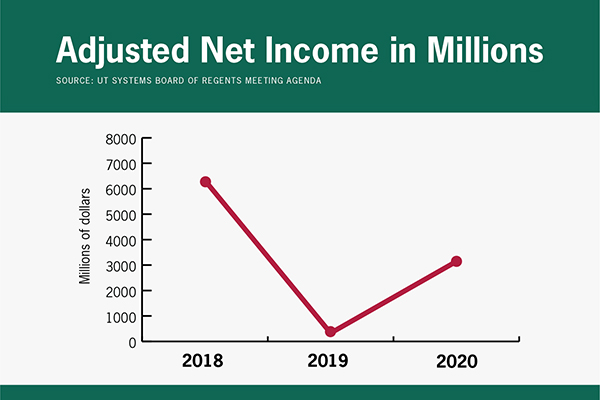This fiscal year’s revenues and expenses of the UT System have remained stable despite the COVID-19 pandemic, according to the UT System’s annual financial reports.
The Daily Texan broke down where the System’s revenue is coming from, how much the UT System spent in fiscal year 2020 and how revenues and expenses compare to previous years using data presented in the UT System Board of Regents’ Feb. 24 and 25 meeting agenda.
UT-Austin is estimated to lose $118 million during fiscal year 2021, which started in Sept. 2020, according to previous reporting by The Daily Texan.
There were some significant funding factors, including the Moody Foundation gift, federal funding to purchase a new supercomputer and $15 million in CARES Act funding, that had a positive impact on UT-Austin’s financial condition, according to an evaluation of UT-Austin’s financial condition in the meeting agenda.
Annual Financial Report
Over the past three years, the adjusted net income for the UT System has not shifted much and was the lowest in the 2019 fiscal year at $328 million. The biggest revenue source in 2019 and 2020 was fees from patient care from the six health institutions under the UT System. The biggest source of expenses in 2020 was compensation and benefits for UT System employees.
Revenue
There were five sources of revenue totaling roughly $10 billion for the UT System in the fiscal year 2020: legislative appropriations, investment returns, University lands, student tuition and fees and philanthropy. Legislative appropriations contributed $1.76 billion. Investment returns from the system’s endowment managed by University of Texas/Texas A&M Investment Management Company contributed $4.19 billion. The total income from University lands added $849.04 million. Student tuition and fee revenue added another $1.94 billion, and philanthropy contributed $1.37 billion.
The contribution to total revenues from investment returns for fiscal year 2020 was $2.21 billion more than fiscal year 2019, when investment returns contributed $1.98 billion.
Philanthropy
For the fiscal year 2020, which began in Sept. 2019 and ended in Aug. 2020, the UT System received $880.97 million in donations. Between fiscal years 2016 and 2020, the lowest total donation amount was in 2017 with $845.65 million. In 2020, $376.1 million came from foundations, $148.8 million came from corporations, $300.2 million came from individuals and $55.8 million came from other sources not disclosed in the meeting’s agenda.
“Like many other services and programs, the pandemic has and will reveal new philanthropic opportunities and strategies,” the agenda said. “We are beginning to see the power of virtual engagement and technology to expand engagement and philanthropic support.”
First Quarter of Fiscal Year 2021
Scott Kelley, executive vice chancellor for business affairs at the UT System, said the UT System as a whole saw a substantial decrease in adjusted income for the first quarter of fiscal year 2021. Adjusted income takes into consideration expenses not included in the gross income, including the amount of depreciation on land and buildings owned by the System. The business affairs committee is predicting a decrease in adjusted income for fiscal year 2021, according to the agenda.
“This is a reflection … of the pandemic,” Kelley said. “We did see enrollment held constant or we actually saw some increases, but there were some additional expenses associated with the pandemic and some additional revenue losses.”




















